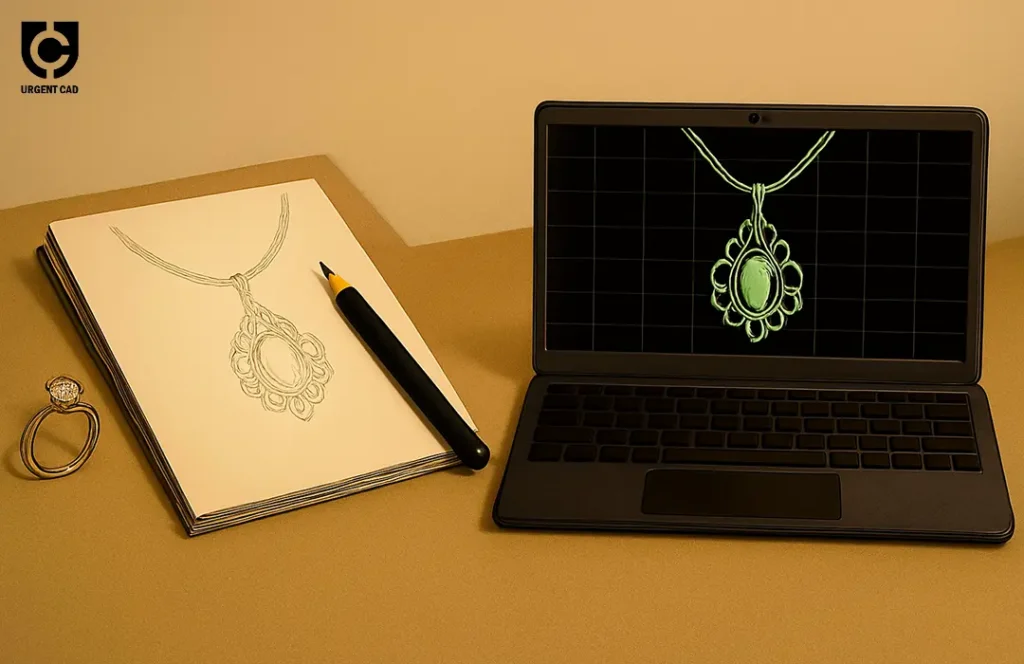
Introduction
Jewellery design has always been about capturing beauty in metal and stone. For centuries, artists relied on paper sketches, steady hands, and imagination to bring ideas to life. Fast forward to today, and the process looks entirely different. Designs no longer stop at pencil drawings; they leap into 3D worlds where every curve and gemstone sparkles on-screen.
This transformation—from paper to pixels—didn’t just change how jewellers work. It reshaped the entire industry. And with tools like urgentcad leading the way, the story of jewellery design continues to unfold in exciting new directions.
The Origins of Jewellery Design
Think back to the early days of jewellery making. Designers would sketch ideas on parchment or carve them into wax. Goldsmiths then painstakingly transformed those sketches into physical pieces. Every necklace, every ring, was born from hours of manual labor and sharp intuition.
This traditional process was intimate and beautiful—but slow. And sometimes, one wrong cut meant starting all over again.
The Limitations of Traditional Design
- Time-Consuming: A single design could take weeks to finalize.
- Human Error: Slight miscalculations often led to wasted material.
- Limited Flexibility: Trying variations meant redrawing or carving each by hand.
Innovation was possible, but not at the speed today’s market demands.
The Digital Shift Begins
The arrival of computers changed the game. Early 2D CAD software gave jewellers a taste of what was possible. Designers could draft precise blueprints faster than hand sketches, ensuring better accuracy.
But the real revolution began when 3D CAD entered the scene.
The Rise of 3D CAD in Jewellery
3D CAD didn’t just improve jewellery design—it reinvented it. Suddenly, jewellers could build lifelike models on screen, rotate them, resize them, and test every detail before production.
Software like urgentcad pushed the boundaries even further. Instead of being general-purpose tools, urgentcad was tailored for jewellery. Pre-built settings, gemstone libraries, and intuitive workflows made it easier for designers to focus on creativity while still maintaining precision.
Benefits of CAD for Jewellers
Accuracy and Detail
CAD eliminates guesswork. Measurements are precise, ensuring stones fit perfectly and structures are strong.
Speed and Efficiency
What once took weeks now takes days—or even hours.
Customization for Clients
Jewellers can now offer multiple variations on the spot. Clients see their ideas in 3D, making the design process interactive.
Realistic Rendering for Marketing
High-quality renders allow jewellers to market pieces before they even exist. That’s a game-changer for online stores and custom commissions.
The Impact of 3D Printing
- Faster Prototyping: Ideas become tangible in hours.
- Fewer Errors: Printed models reveal flaws before final casting.
- Less Waste: Only the necessary material is used.
This shift reduced costs while speeding up production cycles.
Rendering and Visualization in Modern Jewellery
Imagine showing a client a ring that looks real on a screen—every sparkle of the diamond, every reflection of gold. That’s what modern rendering engines deliver.
Jewellers now use renders not just for client approvals but also for digital catalogues and e-commerce. A single render can sell a design before it’s ever made.
Jewellery Design Meets Artificial Intelligence
- Pattern Generation: AI can suggest intricate patterns that humans might not imagine.
- Predictive Design: It anticipates client preferences based on past choices.
- Integration with urgentcad: Some platforms now blend AI with traditional CAD, offering smarter suggestions.
Virtual Reality (VR) and Augmented Reality (AR) in Jewellery
- AR Try-Ons: Clients use their phones to see how a ring looks on their finger.
- VR Showrooms: Walk through a digital boutique without leaving your sofa.
This tech makes jewellery shopping more engaging and personal.
Outsourcing in the Digital Age
As technology advanced, so did business models. Many jewellers now outsource CAD design to specialized firms.
Why? It saves time, reduces costs, and provides access to skilled experts. Tools like urgentcad make outsourcing smoother by standardizing workflows and ensuring compatibility across teams.
Sustainability through Technology
Designing digitally isn’t just convenient—it’s sustainable. CAD and 3D printing minimize wasted materials. Virtual prototypes replace multiple physical samples. And with precise planning, production becomes far more eco-friendly.
Challenges in Adapting to Technology
- Older artisans sometimes struggle with the learning curve.
- High-end software and hardware can be expensive.
- Some fear losing the “human touch” in jewellery design.
But most agree: the benefits outweigh the challenges.
The Future of Jewellery Design
- Fully immersive VR design studios.
- AI assistants offering design suggestions.
- Hyper-personalized jewellery created on demand for each customer.
The line between imagination and reality will blur even more.
Tips for Designers in the Digital Era
- Blend Tradition with Technology: Keep sketching, but learn CAD.
- Stay Updated: Tools like urgentcad evolve quickly—keep learning.
- Join Communities: Online forums and design groups help you grow and stay inspired.
Conclusion
From paper to pixel perfect 3D models, jewellery design has undergone a remarkable journey. Technology didn’t erase tradition—it amplified it. Designers today have more tools, more precision, and more freedom than ever before.
Whether it’s CAD software like urgentcad, 3D printing, or AI, one thing is clear: jewellery design will keep evolving. And with every new step, it gets easier for artists to bring their visions to life.
FAQs
- Why was CAD a game-changer in jewellery design?
Because it introduced precision, speed, and flexibility, making designs more accurate and customizable. - What role does urgentcad play in modern jewellery design?
urgentcad streamlines jewellery-specific workflows, making design faster and easier for professionals. - Can traditional artisans adapt to digital design easily?
Yes, with patience and training. Many artisans blend handcrafting skills with CAD. - How does 3D printing help jewellers?
It turns CAD models into prototypes quickly, reducing errors and saving costs. - What’s next for jewellery design technology?
Expect AI, VR, and AR to play a bigger role, making jewellery design more interactive and personalized.


